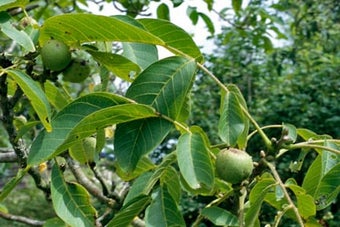
Quick facts
Common name - Walnut leaf blotch
Scientific name - Ophiognomonia leptostyla
Plants affected - Walnut
Main symptoms - Brown leaf spots and blotches, leading to premature defoliation. Sunken, brown blotches on the outside of the fruit. Browning and shrivelling of nuts
Caused by - Fungus
Timing - Summer, particularly in wet conditions
What is walnut leaf blotch?
Walnut leaf blotch is a fungal disease that is favoured by wet weather. It is seen most commonly on the leaf blades but can affect any green part of the tree, including petioles (leaf stalks), young shoots and fruits.
Severely affected trees can lose most of their leaves by late July, but the disease has little long-term effect on the vigour of a mature tree. However, the fruit can be completely ruined.
Symptoms
You may see the following symptoms:
- Brown, roughly circular leaf spots, a few millimetres in diameter
- The spots merge together to form larger, irregular brown blotches, often with a yellow margin
- Severely affected leaves shrivel and fall prematurely
- Sunken brown blotches may develop on petioles, young shoots and the outer case of the fruit. Some affected fruits may fall
- Developing nuts shrivel and turn black

Control
Non-chemical control
- Ensure that any leaves falling prematurely from an affected tree are collected and disposed of (by burning, burial or consigning to the council ), together with all the rest of the leaves when they fall in the autumn
- Vigorous, healthy trees tend to be more resistant to attack. Young trees in particular will benefit from feeding in spring, and watering regularly during dry spells
Chemical control
There are no fungicides available to home gardeners for the control of walnut leaf blotch.
Other symptoms on walnut leaves
Walnut leaves can be affected by a number of other pests and diseases, although none is as damaging as leaf blotch.
Bacterial leaf blight is caused by the bacterium Xanthomonas arboricola pv. juglandis, which produces numerous tiny, angular, brown spots on the leaves. Brown blotches may also develop on the fruit. This disease can be very damaging in parts of Europe, but is rarely a significant problem in the UK. Dispose of affected leaves and fruit where it occurs. Resistant cultivars are available.
White leaf spot is caused by the fungus Pseudomicrostroma juglandis. Conspicuous white fungal growth surrounds the veins on the underside of the leaf. No control is necessary.
Walnut blister mite (Aceria erineus) causes characteristic upwards bulging of the leaf surface. The upper surface of the galled area is yellowish-purple, and the underside is densely covered in creamy-white hairs. There is no effect on vigour, and no control is necessary.
Biology
Walnut leaf blotch is caused by the fungus Ophiognomonia leptostyla. It fluctuates in severity from year to year, being most damaging in wet summers.
Tiny fruiting bodies develop in spring on fallen leaves at the base of the tree. Following rainfall, these fruiting bodies produce spores that are carried upwards by rain splash and in air currents to infect the new season’s growth. Once leaf spots have developed, a second spore type is produced on them, which continues to spread the disease throughout the summer. Several hours of leaf wetness are required in order for either of the spore types to germinate and infect.
Even if the fruits are not directly attacked by the fungus, the nuts are often rendered inedible when a tree suffers significant leaf fall whilst they are still developing. However, severe leaf loss from late July onwards has little effect on the overall vigour of the tree itself (unless it is young, or early defoliation occurs repeatedly for several years), as by this time the leaves have already made the majority of their contribution to that year’s growth.




